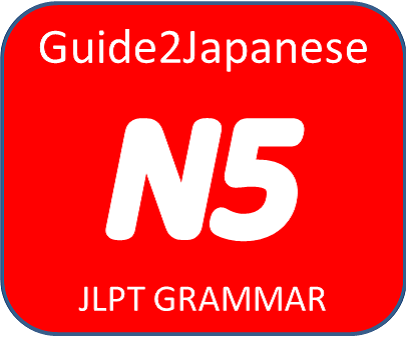JLPT N5 GRAMMAR: ~で Particle
Meaning: By / in / with/at [~(इस/उस/पर)से, ~में ( से )]
The particle “で has different usage in a sentence, let us see one by one.
Example sentences:
The particle “で”indicates a means or method.
When added after a noun denoting a place, “で” indicates the place where an action occurs.
- バスで会社へ行きます。
- Basu de kaisha e ikimasu.
- I will go to the office by bus.
- मैं बस से ऑफिस जाऊंगा।
- ラジオで日本語を勉強しました。
- Rajio de nihongo o benkyō shimashita.
- I studied Japanese on the radio.
- मैंने रेडियो पर से जापानी का अध्ययन किया।
- 私は中国語でレポートを書きます。
- Watashi wa chūgokugo de repōto o kakimasu.
- I write reports in Chinese.
- मैं चीनी में (से) रिपोर्ट लिखता हूं।
- 私ははしで食事します。
- Watashi wa hashi de shokuji shimasu.
- I eat with chopsticks.
- मैं चॉपस्टिक से खाता हूं।
- 「何でうちへ帰りました。」「タクシーで帰りました。」
- Nani de uchi e kaerimashita.’`Takushī de kaerimashita.’
- “How did you go home?” “I took a taxi.”
- “तुम घर किससे गए?” “मैं टैक्सी से लौटा।”
- 「だれと日本へ来ましたか。」「一人で来ました」
- `Dare to Nihon e kimashita ka.’`Hitori de kimashita’
- “Who did you come to Japan with?” “I came alone.”
- “आप जापान किसके साथ आए थे?” “मैं अकेला आया था।
- 駅で新聞を買います。
- Eki de shinbun o kaimasu.
- I buy newspaper at the station.
- मैं स्टेशन पर से अखबार खरीदता हूं।
When added after a noun denoting a place, “で” indicates the place where an action occurs.
- 「どこで写真を撮りますか」「…庭で撮ります。」
- `Doko de shashin o torimasu ka’`… niwa de torimasu.’
- “Where do you take a picture?” “… take a picture in the garden.”
- “तुम फोटो कहाँ पर से लोगे?” “… बगीचे में से लुंगा।”
- 会社の食堂で昼ご飯を食べます。
- Kaisha no shokudō de hiru gohan o tabemasu.
- I take lunch at the company cafeteria.
- दोपहर का भोजन कंपनी के कैफेटेरिया में (से) करता हु।
- スーパーで牛乳を買いました。
- Sūpā de gyūnyū o kaimashita.
- I bought milk at the supermarket.
- मैंने सुपरमार्केट में से दूध खरीदा।
- 国で日本語を勉強しました。
- Kuni de nihongo o benkyō shimashita.
- I studied Japanese in the country.
- मैंने देश में (से) जापानी का अध्ययन किया।
When some action takes place on a certain occasion, that occasion is followed by で。
- 会議で何か意見を言いましたか。
- Kaigi de nanika iken o iimashita ka.
- Did you give your opinion at the meeting?
- क्या आपने बैठक में अपनी बात कही?
で added to quantifier indicates the limit of a price, time, quantity etc. necessary for a state, an action or an event to be realized.
- 駅まで30ぷんで行けますか。
- Eki made 30 pun de ikemasu ka.
- Can I reach the station in thirty minutes?
- क्या 30 मिनीट मे स्टेशन पर जाना संभव है?
- 3万円でビデオを買えますか。
- 3 Man-en de bideo o kaemasu ka.
- Can I buy a video for 30000yen?
- क्या मैं 30,000 येन मे एक वीडियो खरीद सकता हूं?
Particle で is also refers to cause when places after nouns indicating natural phenomenon, happenings, events like 事故、地震、火事 etc. Volition expressions are not used as predicates in such sentence.
- 地震でビルが倒れました。
- Jishin de biru ga taoremashita.
- Because of earth quake, a building collapsed.
- भूकंप के कारण इमारत ढह गई ।
- 病気で明日会社を休みました。
- Byōki de ashita kaisha o yasumimashita.
- Because of illness I took a day off.
- बीमारी के कारण मैंने एक दिन की छुट्टी ली।



